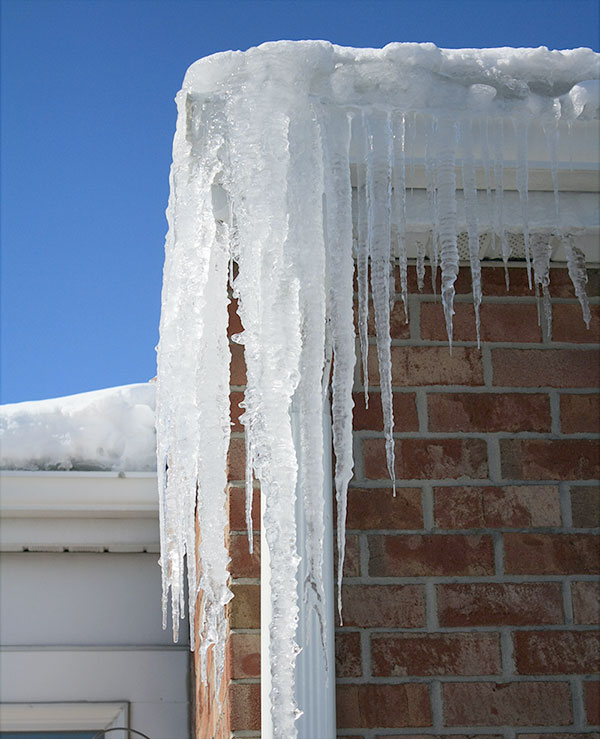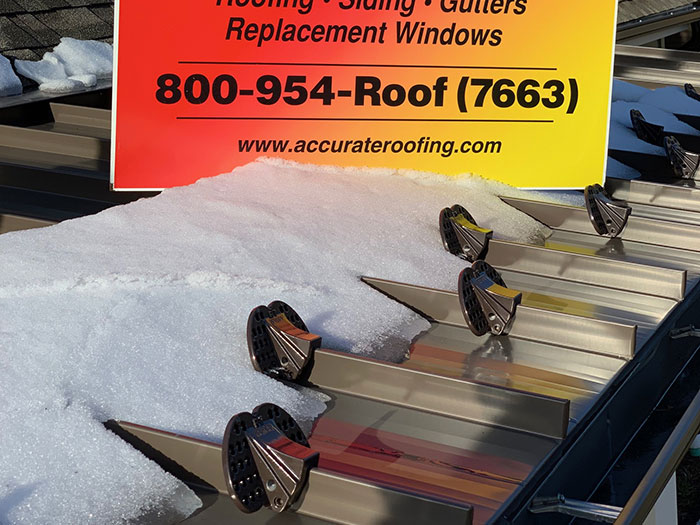Ice dams, snow on your roof, and attic condensation
Why should you worry about snow on your roof?


Heavy loads of ice and snow on your roof can create serious problems like:
- injuries from snow and ice falling from sloped roofs
- roof collapse, especially on flat roofs
- carbon monoxide poisoning resulting from blocked chimneys and vents
- water damage from ice dams that form on the edges of roofs and in gutters
What are ice dams?
When the temperature in your attic is above freezing, snow on the roof will likely melt. When the snowmelt runs down the roof and hits the colder eaves, it refreezes.
If this cycle repeats over several days, the freezing snowmelt builds up and forms a dam of ice, behind which water pools up into large puddles, or "ponds". The ponding water can then back up under the roof covering and leak into the attic or along exterior walls.
The right weather conditions for ice dams are usually when outside air temperatures are in the low 20s (°F) for several days with several inches of snow on the roof.
What causes condensation in your attic?
Condensation of water vapor on cold surfaces in attics can cause wood to rot, which can lead to costly repairs.
Condensation in the attic typically occurs when warm, moist air migrates or is directed into the attic from living spaces below. Research indicates unusually high humidity in the home's living spaces is strongly associated with attic condensation problems.
What are some warning signs to watch for?
Recognize the signs of stress when too much snow and ice has accumulated on your roof or when you have too much condensation in your attic:
- sagging ridgeline
- drooping ceilings
- water leaks on interior walls and ceilings
- jammed doors
- cracked interior walls near the center of your home
- creaking sounds
Condensation, snow on roof, and ice dam prevention tips
First and foremost, it's your builder or designer's job to understand the relationship of humidity and air movement when designing and constructing the house so these problems don't occur.
Here are a few simple steps that can help prevent snow build up on the roof, ice dams and condensation in your attic:
- Bathroom and kitchen exhaust fans , as well as dryer vents, should never be discharged into the attic space and always discharge outside. You may have an adequately ventilated attic, but this won't matter if the bathroom exhaust fan dumps warm moist air directly into the attic space. This could result in condensed water vapor freezing onto cold attic materials, which will eventually thaw creating wet attic materials resulting in damage in the attic and inside the home.
- Minimize ceiling mounted fixtures below the attic that create the need for holes in the drywall or plaster ceiling. Properly seal ceiling penetrations to make them airtight taking care to follow manufacturer clearance requirements for flues, chimneys, and recessed light fixtures.
- Research shows keeping the attic air temperature below freezing when the outside air temperature is in the low 20s can reduce the occurrence of ice dams. Proper attic ventilation is key to keeping the attic cool, while adequate and properly installed insulation is key to keeping your house warm. It is critical to keep soffit vents free from obstructions to allow the natural flow of cool outside air into the attic space to replace the warmer attic air that rises and flows outside the ridge and/or roof vents. This flow of air will keep the attic cool and free of moisture build-up.
Do not attempt removing ice and snow from your roof yourself. Avoid injury by hiring a professional to remove snow and ice from the roof and fix the problem before it leads to property damage and expensive repairs. Here are some tips though to keep in mind:
- Add insulation to your attic to help prevent your home's warm air from escaping into unheated attic spaces.
- If replacing your home's roof, have a self-sealing membrane installed under the shingles to help prevent water damage from ice dams.
- On metal roofs, install snow guards above entrances.
If your home suffers damage this winter, contact your insurance agent to find out if it's covered under your homeowner's policy.